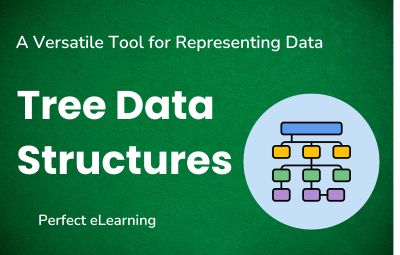

Tree data structures are versatile representations of data, organizing information hierarchically for efficient retrieval & manipulation.
In the realm of computer science, data structures play a pivotal role in organizing and storing data efficiently. One such fundamental and versatile structure is a tree. Unlike linear data structures such as arrays or linked lists, trees offer a hierarchical arrangement that allows for more complex relationships between data elements.
1. Types of Tree Data Structures
1.1 Binary Trees
Among the various types of trees, binary trees stand out with their hierarchical structure where each node has at most two children, known as the left child and the right child.
1.2 AVL Trees
AVL trees, named after their inventors Adelson-Velsky and Landis, are self-balancing binary search trees that ensure the tree remains balanced, providing quicker search, insertion, and deletion operations.
1.3 Red-Black Trees
These are another type of self-balancing binary search trees that maintain balance by using coloring schemes and rotation operations.
1.4 B-trees
B-trees are multiway search trees commonly used in file systems and databases due to their ability to maintain large amounts of data while ensuring efficient search and retrieval operations.
1.5 Trie Data Structures
Trie structures specialize in handling sequences of characters or keys, making them efficient for tasks like autocomplete and dictionary implementations.
2. Advantages and Applications
Tree data structures offer exceptional efficiency in search, insertion, and deletion operations. Their applications span across various domains including database management systems, compiler designs, network routing algorithms, and more. Comparatively, they often outperform other data structures in scenarios involving large datasets.
3. Tree Data Structure Operations
The operations involved in tree structures include insertion and deletion of nodes, traversal techniques such as inorder, preorder, and postorder traversals, and specialized searching algorithms optimized for tree structures.
4. Balancing and Optimization
Maintaining balance within trees is crucial for optimal performance. Techniques like rotation, rebalancing, and adjusting node heights ensure that trees remain balanced, preventing skewed structures that may hinder efficiency.
5. Challenges and Considerations
Despite their advantages, implementing tree data structures can pose challenges such as complexity in algorithms, memory management, and choosing the appropriate tree structure based on specific requirements and constraints.
6. Future Trends and Innovations
The landscape of tree data structures continues to evolve with ongoing research and innovations. Emerging trends focus on enhancing the efficiency and scalability of these structures to meet the demands of modern computing.
Conclusion
In conclusion, tree data structures stand as a cornerstone in computer science, offering a versatile and efficient means of organizing and representing data. Their ability to handle vast amounts of information while maintaining performance makes them an indispensable tool across various applications.
Frequently Asked Questions (FAQs)
Q1. Are trees the best data structure for all scenarios?
A1: Trees excel in many scenarios, but the choice of data structure depends on the specific requirements of the problem. For instance, arrays might be more suitable for simple sequential access.
Q2. What makes balancing in trees so important?
A2: Balancing ensures that the tree remains relatively balanced, which guarantees efficient operations like search, insertion, and deletion, preventing skewed structures that could slow down performance.
Q3. How do tree data structures differ from other hierarchical structures?
A3: Trees distinguish themselves with their branching hierarchical structure, enabling more complex relationships among data elements compared to linear structures like arrays or linked lists.
Q4. Can tree structures handle large datasets efficiently?
A4: Yes, tree structures are known for their efficient handling of large datasets due to their logarithmic time complexity in operations, making them suitable for various applications.
Q5. What advancements can we expect in tree data structures in the near future?
A5: Future advancements may focus on enhancing concurrency, further optimizing operations, and developing hybrid tree structures to cater to evolving computational demands.
Perfect eLearning is a tech-enabled education platform that provides IT courses with 100% Internship and Placement support. Perfect eLearning provides both Online classes and Offline classes only in Faridabad.
It provides a wide range of courses in areas such as Artificial Intelligence, Cloud Computing, Data Science, Digital Marketing, Full Stack Web Development, Block Chain, Data Analytics, and Mobile Application Development. Perfect eLearning, with its cutting-edge technology and expert instructors from Adobe, Microsoft, PWC, Google, Amazon, Flipkart, Nestle and Info edge is the perfect place to start your IT education.
Perfect eLearning provides the training and support you need to succeed in today's fast-paced and constantly evolving tech industry, whether you're just starting out or looking to expand your skill set.
There's something here for everyone. Perfect eLearning provides the best online courses as well as complete internship and placement assistance.
Keep Learning, Keep Growing.
If you are confused and need Guidance over choosing the right programming language or right career in the tech industry, you can schedule a free counselling session with Perfect eLearning experts.


